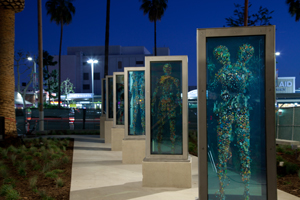
Developers in Los Angeles get hit with city charges for just about everything, and as the fees have multiplied, so have developers’ frustrations. But there’s one levy that some developers have embraced: a 1 percent fee on commercial projects exceeding $500,000 in value that is applied to fund public art projects.
Kilroy Realty Corp. of West Long Angeles is one of those developers. Last fall at its Columbia Square project in Hollywood, Kilroy unveiled a public art installation: a row of translucent panels featuring human figures by celebrity artist Dustin Yellin.
Kilroy was only obligated under the city’s 1 percent for public art mandate to pay about $600,000 for the work, but the developer ended up spending nearly double that to make sure it could be displayed to maximum effect – and spent the extra money willingly.
“We wanted to do more than just fulfill the funding requirement,” said Lauren Phillips, Kilroy’s director of construction services. “We wanted to bring something new and exciting to the project and have the art make as much impact as possible.”
The Columbia Square panels are among the more recent of several hundred public art displays around Los Angeles made possible by the city’s 1 percent mandate. Established in 1989, it’s one of the oldest in the country – and regarded as one of the better run programs with dozens of local artists as frequent participants.
According to the Cultural Affairs Department, the mandate has generated roughly $35 million for public art over the past decade. No cumulative figures were available for the total number of public art installations and programs funded, though department staff said the agency had completed 66 art projects that it managed over the past four years.
Los Angeles is not alone – 32 other cities in Los Angeles County have a levy for public art mandates, according to a 2011 report from the Los Angeles County Arts Commission. Of those, Culver City’s is the oldest, established in 1988. Other cities that have since set up programs include Alhambra, Long Beach, Beverly Hills, Santa Monica, Glendale, and Westlake Village.
Most of the other cities have a 1 percent set-aside requirement, though a few have slightly higher or lower percentages.
Malibu fine art consultant DeeDee Postil said that while the programs in these cities generally don’t have major problems, few match up to the quality and breadth of art and level of experience in Los Angeles.
“The city of Los Angeles has really emerged as the gold standard among these programs,” she said.
Increased involvement
In Los Angeles, the mandate is limited to commercial developments (in mixed-use projects, only the commercial component, not the residential). Developers have three choices: They can turn the funds over to the city’s Cultural Affairs Department and leave all the work to the city; they can hire their own team to select the artist and plan the installation; or they can work in tandem with the city.
In the mandate’s early days, many developers simply paid their fees to the city and wanted little more to do with it, according to Edward Goldman, a local art critic. Department of Cultural Affairs staff would then choose the artists and find nearby sites to place the art.
That practice has changed over time as more developers have taken it upon themselves – and hired consultants – to select artists and prepare their project sites.
Initially, some developers had to be dragged into the process, fearful that they might run into bureaucratic delays that could postpone the opening of their project, according to Michelle Isenberg, a local fine art consultant who has worked on percent for public art projects in downtown Los Angeles and Culver City, at Los Angeles International Airport, and elsewhere. Isenberg is advising Chinese developer Greenland USA on its public art installation at downtown’s Metropolis project and Korean Air Lines on its Wilshire Grand development.
More recently, though, as word has spread that delays are infrequent and city staff are relatively accommodating, an increasing number of developers have taken on the tasks themselves.
“The developer experience has opened up; early on it was really difficult,” Isenberg said. “There were lots of location and medium restrictions; those have loosened up over the years. Now, L.A. is considered a national leader in percent for public art programs.”
